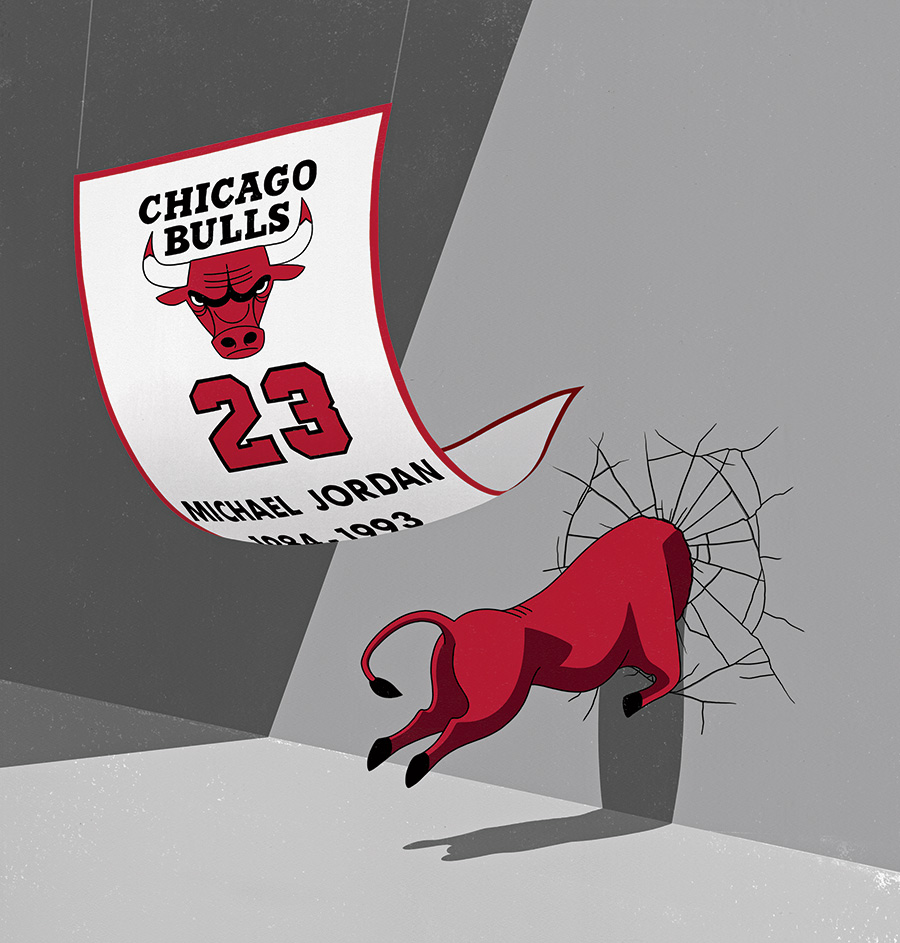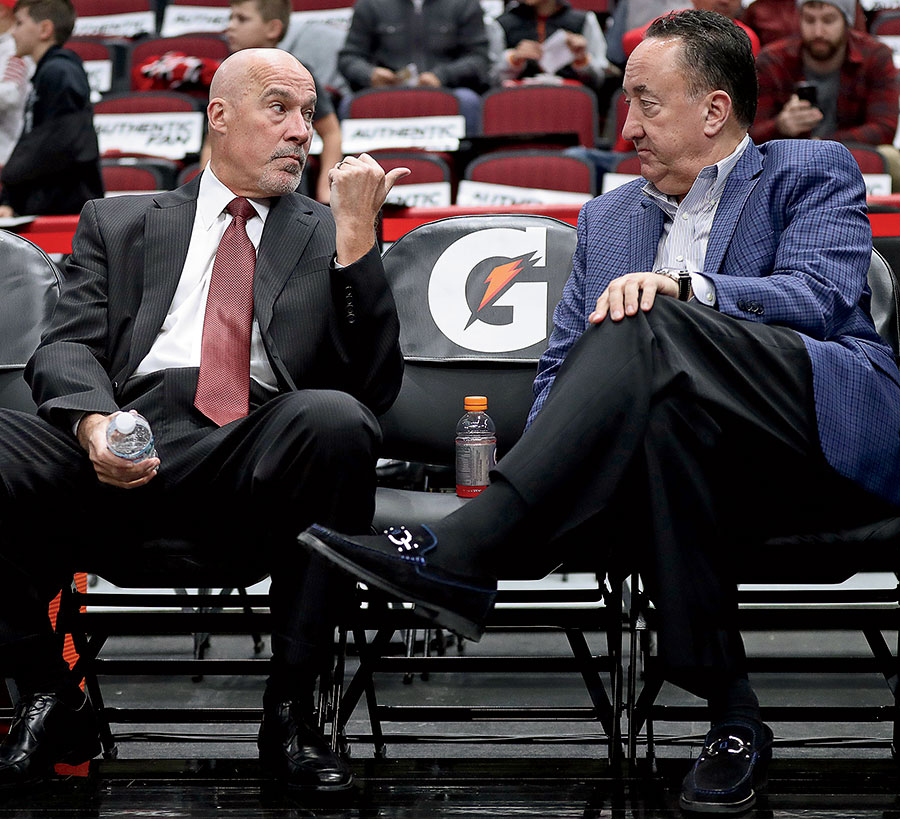
One recent afternoon, the towering video panels on the United Center’s façade projected a photograph of Michael Jordan sobbing joyfully into the Larry O’Brien Trophy, the first of six he would bring to Chicago. Visitors can pose for photos next to a comically oversize replica of the trophy inside a gift shop that hawks Jordan jerseys for $300 a pop. Mercifully, there’s no fee to view the bronze statue of His Airness, the granite base of which proclaims: “The best there ever was. The best there ever will be.” The way things are going — two decades and running without a single NBA Finals appearance — the same could be said of Jordan’s ’90s Bulls teams.
It’s certainly easier to mine the triumphs of the past than to build another juggernaut in the present. This past January, a month in which the Bulls won just two of 15 games, marked the 20th anniversary of Jordan’s second retirement. That final act in the dissolution of the dynasty signaled the start of the Bulls’ inability to secure franchise-changing players in free agency. Head coach Phil Jackson retreated to his Montana cabin. Scottie Pippen was traded to Houston. Meanwhile, Jordan blamed the end of the run on his longtime archrival, the much-maligned late general manager Jerry Krause, who had enraged the title-winning squads by infamously suggesting that it’s the organizations — not players — that win championships.
The ugly divorce and Jordan’s immediate estrangement scared off free agents. Future Hall of Famer Kevin Garnett, whom the Bulls once tried to woo, told ESPN: “If they crapped on one of the best players to ever play the game, then why would I want to go there?” Says Roland Lazenby, author of five books on Jordan’s era: “The destruction of that team was like a nuclear reactor melting down. The fallout is still being felt to this day.”
For the past 10 years, vice president of basketball operations John Paxson, Jordan’s former teammate, and GM Gar Forman have headed up the front office together. The pair is better known to dyspeptic fans by the epithet GarPax, which evokes an ineffectual two-headed monster that has, among other transgressions, blown bids to sign LeBron James and in-his-prime Carmelo Anthony.
“The Bulls can do rebuild after rebuild, but eventually they’ll need stars. Stars aren’t attracted to a guy [like Forman] who comes off as a used-car salesman,” says Joe Cowley, the Sun-Times’ Bulls reporter. “A lot of players have left Chicago pissed off.” After the team traded Jimmy Butler in 2017, the All-Star’s trainer tweeted that Forman was “a liar” and that he had “met drug dealers with better morals.” The following month, angry fans crowdfunded a #FireGarPax billboard that went up in the West Loop. “The Bulls had to address the Gar situation, and I think they finally did,” Cowley says. “Paxson’s become more the voice and face. Players respect him a lot more.”
Yet there’s reason to be dissatisfied with Paxson, too. Having assumed GM duties from Krause in 2003 (then named VP when Forman was promoted in 2009), he’s the third-longest-tenured executive in the NBA. He’s been given multiple chances to revive the franchise yet has seen only one deep playoff run, when the Bulls got snuffed out in the 2011 conference finals. “If [the latest rebuild] doesn’t work, then the people who want me out will probably get their wish,” Paxson said in a radio interview last December. (He later claimed the comment was facetious.)

One big test will be if Paxson can finally land a major free agent. His hope is that the development of the Bulls’ young talent — namely Lauri Markkanen, Zach LaVine, and Wendell Carter Jr. — will make Chicago a desirable destination by the time reigning MVP Giannis Antetokounmpo and NBA Finals MVP Kawhi Leonard hit the market in 2021.
For most of last season, though, the Bulls received attention for the wrong reasons. After firing coach Fred Hoiberg 24 games in, they promoted assistant Jim Boylen, who waged a “shock and awe” campaign of lengthy practices that included military-style pushups. In his first week, he narrowly avoided a player mutiny when he scheduled a practice after back-to-back games, the second of which was a 56-point loss — the worst defeat in franchise history. “I’m the first to admit that [Boylen’s] first week was like dynamite blowing up,” Paxson said at the end of the season. “Jim’s going to rub players the wrong way sometimes. The great ones do.”
But following the February acquisition of forward Otto Porter Jr., the Bulls showed a glimmer of promise, delivering an offensive efficiency (based on points per 100 possessions) bested only by Houston’s James Harden Show. In the off-season, the Bulls made some smart-looking changes, dumping Jabari “They Don’t Pay Players to Play Defense” Parker and adding solid two-way veterans Tomas Satoransky and Thaddeus Young. “I like the moves they’ve made,” says Sam Smith, author of the seminal locker-room tell-all The Jordan Rules. “There’s finally adults in the room who’ve got some skills.”
Despite the team finishing 22–60, Boylen seemed to eventually endear himself to his troops. Case in point: LaVine, who had spearheaded the near insurrection, offered in March to pay his coach’s fine for arguing with Clippers coach Doc Rivers. Still, Boylen’s Bobby Knight routine stands to frighten away future free agents. In an April poll by the Athletic, NBA players were asked, “Which coach, aside from your own, would you not want to play for?” Boylen garnered the most votes among active coaches.
First-round draft pick Coby White, for one, likes Boylen, calling him “my type of coach.” At a press conference the team held to introduce White, one reporter noted, “The last time the Bulls drafted a guard from North Carolina, it worked out pretty well.” White, who has dutifully proclaimed Jordan “the GOAT,” had the good sense to smile sheepishly and bury his face in his hand.


